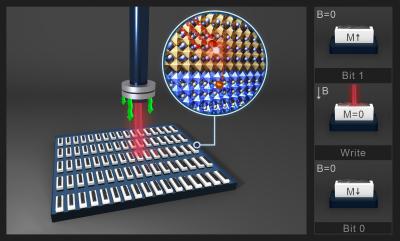Physicists at the Ãcole polytechnique fédérale de Lausanne (EPFL) in Switzerland have used perovskite materials to alter a magnetic bit's polarity with light, potentially opening the door to denser and faster disk drives using magneto-optical technology.

Researchers László Forró, Bálint Náfrádi, Péter Szirmai and Endre Horváth suggest magneto-optical drives using this method could be physically smaller, faster and cheaper than today's disk drives. They also say it is an alternative to heat-assisted magnetic recording (HAMR).
The EPFL team used visible light waves to write and re-write magnetic bits at room temperature. Previously it had only been possible by cooling a magnet to '180 degrees Celsius.
The researchers used a halide perovskite/oxide perovskite heterostructure, and the abstract of their scientific paper states 'demonstrate that photo-induced charge carriers from the CH3NH3PbI3 photovoltaic perovskite efficiently dope the thin La0.7SR0.3MnO3 film and decrease the magnetization of the ferromagnetic state, allowing rapid rewriting of the magnetic bit.'
The Swiss researchers placed a thin film of perovskite material on top of a magnetic substrate. Their paper states: 'We use a sandwich of a highly light sensitive (MAPbI3) and a ferromagnetic material (LSMO), where illumination of MAPbI3 drives charge carriers into LSMO and decreases its magnetism.'
MAPbI3 is Methylammonium lead bromide and LSMO is Lanthanum strontium manganite; both are perovskites.



